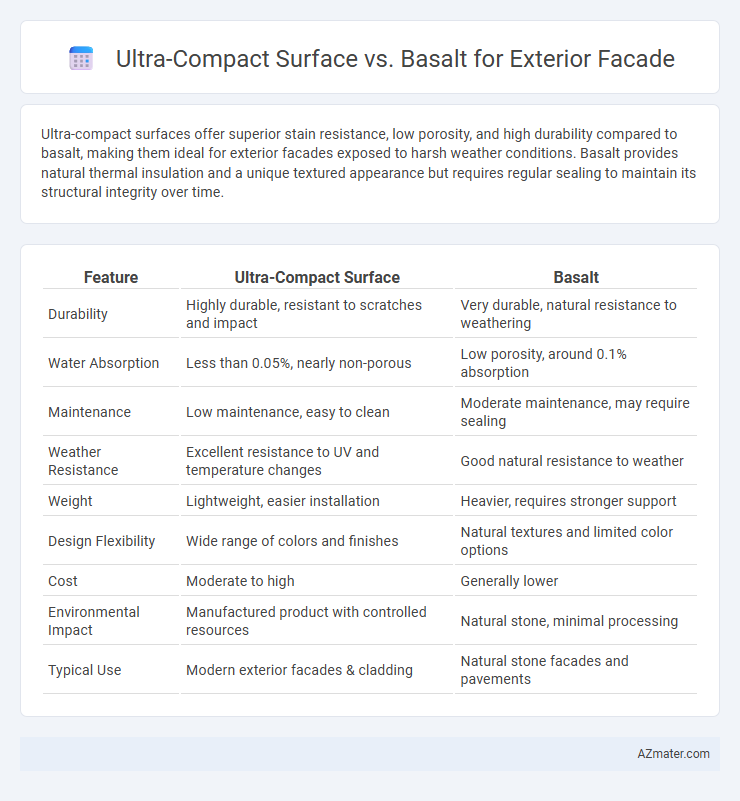Ultra-compact surfaces offer superior stain resistance, low porosity, and high durability compared to basalt, making them ideal for exterior facades exposed to harsh weather conditions. Basalt provides natural thermal insulation and a unique textured appearance but requires regular sealing to maintain its structural integrity over time.
Table of Comparison
| Feature | Ultra-Compact Surface | Basalt |
|---|---|---|
| Durability | Highly durable, resistant to scratches and impact | Very durable, natural resistance to weathering |
| Water Absorption | Less than 0.05%, nearly non-porous | Low porosity, around 0.1% absorption |
| Maintenance | Low maintenance, easy to clean | Moderate maintenance, may require sealing |
| Weather Resistance | Excellent resistance to UV and temperature changes | Good natural resistance to weather |
| Weight | Lightweight, easier installation | Heavier, requires stronger support |
| Design Flexibility | Wide range of colors and finishes | Natural textures and limited color options |
| Cost | Moderate to high | Generally lower |
| Environmental Impact | Manufactured product with controlled resources | Natural stone, minimal processing |
| Typical Use | Modern exterior facades & cladding | Natural stone facades and pavements |
Introduction to Ultra-Compact Surface and Basalt
Ultra-compact surface materials offer exceptional durability, resistance to scratches, stains, and UV rays, making them ideal for exterior facades that require low maintenance and long-lasting aesthetics. Basalt, a natural volcanic rock, is highly valued for its robustness, thermal stability, and unique textured appearance, providing a sustainable and attractive option for exterior cladding. Both materials excel in weather resistance and longevity, with ultra-compact surfaces delivering a modern, sleek finish while basalt presents a naturally rugged and organic facade option.
Composition and Manufacturing Differences
Ultra-compact surfaces are engineered materials composed primarily of natural minerals like quartz, feldspar, and porcelain, combined through high-pressure and high-temperature sintering processes that enhance density and surface hardness. Basalt, a natural volcanic rock, undergoes minimal processing involving cutting and finishing without significant alteration to its inherent mineral composition. The manufacturing of ultra-compact surfaces relies on advanced technology to achieve uniformity and enhanced performance, whereas basalt's durability and texture depend on its natural crystalline structure and geological formation.
Aesthetic Versatility: Design Options
Ultra-compact surfaces offer an extensive range of textures, colors, and finishes that mimic natural materials like stone, wood, and metal, enabling highly customized and contemporary exterior facade designs. Basalt provides a more limited palette with natural stone aesthetics characterized by its dark, uniform tones and rugged texture, suitable for traditional or minimalist looks. The ultra-compact surface's adaptability surpasses basalt in achieving innovative architectural expressions and complex geometric patterns on building exteriors.
Durability and Weather Resistance Comparison
Ultra-compact surfaces exhibit superior durability compared to basalt, resisting scratches, stains, and impacts due to their dense, non-porous composition. Weather resistance is enhanced in ultra-compact materials as they withstand UV radiation, freeze-thaw cycles, and chemical exposure without deterioration, unlike basalt which may suffer from erosion and frost damage over time. These properties make ultra-compact surfaces ideal for exterior facades requiring long-lasting performance in diverse climates.
Maintenance Requirements and Longevity
Ultra-compact surfaces offer exceptional durability and resistance to stains, scratches, and weather conditions, resulting in minimal maintenance needs for exterior facades. Basalt, a natural volcanic stone, provides strong longevity and natural resistance but may require periodic sealing and cleaning to maintain its appearance over time. Choosing ultra-compact surfaces ensures lower upkeep costs and extended facade life compared to basalt's moderate maintenance demands.
Environmental Sustainability and Impact
Ultra-compact surface panels offer superior environmental sustainability compared to basalt by using less natural resource extraction and featuring recyclable materials, reducing overall ecological impact. Basalt, while naturally durable and abundant, requires energy-intensive quarrying and processing that contributes to higher carbon emissions. Choosing ultra-compact surfaces supports lower lifecycle carbon footprints and promotes eco-friendly facade construction.
Thermal Performance and Energy Efficiency
Ultra-compact surface materials offer superior thermal insulation compared to basalt, reducing heat transfer and enhancing building envelope performance. Their low porosity and high density contribute to improved energy efficiency by maintaining stable indoor temperatures and lowering HVAC energy consumption. Basalt, while naturally durable and fire-resistant, typically exhibits higher thermal conductivity, resulting in less effective thermal performance for exterior facades.
Cost Analysis: Short-term vs Long-term Investment
Ultra-compact surfaces generally present a higher initial cost compared to basalt, driven by advanced manufacturing and installation techniques. Basalt, being a natural stone, tends to have lower upfront expenses but may incur increased maintenance and potential replacement costs over time due to weathering. Long-term investment in ultra-compact surfaces can prove more cost-effective as they offer superior durability, resistance to stains, and minimal upkeep, reducing lifecycle expenses significantly.
Installation Challenges and Considerations
Ultra-compact surfaces, known for their lightweight and thin profile, offer easier handling and faster installation compared to dense basalt panels, which require heavy machinery and skilled labor due to their weight and density. The precise cutting and alignment needed for ultra-compact materials reduce on-site adjustments, whereas basalt's natural irregularities demand more customization and increased installation time. Moisture resistance and thermal expansion characteristics also differ, necessitating tailored fixing systems and joint designs for each material to ensure long-term durability and facade integrity.
Best Use Cases for Exterior Facades
Ultra-compact surfaces excel in exterior facades due to their high resistance to weathering, UV rays, and stains, making them ideal for commercial buildings in harsh climates. Basalt offers exceptional natural durability and thermal insulation, suitable for eco-friendly residential facades and historic restoration projects. Choosing between ultra-compact surfaces and basalt depends on specific project needs such as maintenance preferences, environmental impact, and aesthetic goals.

Infographic: Ultra-compact surface vs Basalt for Exterior Facade
 azmater.com
azmater.com